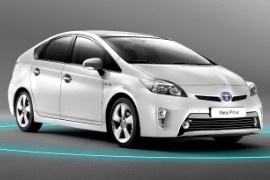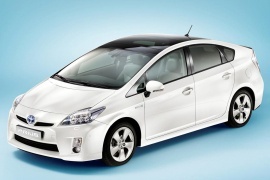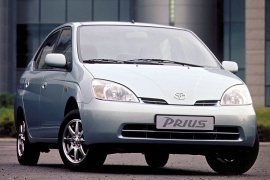
TOYOTA Prius
Generations Timeline, Specs and Pictures

Adding an all-wheel-drive system to a car was never a bad idea.
But when that happened to one of the most known hybrid vehicles in the world, it’s great news.
Toyota has succeeded in promoting the Prius as one of the most important revolutions in automotive history. It was the car that made the hybrid vehicles desirable. Despite its arguable design, it was a big hit. It was introduced in 1997, and in 2015 it launched the fourth generation, which was revised in 2018.
There were not too many things that were modified from the outside compared with the non-facelifted version. The headlights were enhanced with a standard bi-LED system. The taillights used the same technology as well.
The 2015 model was introduced with a somehow outdated infotainment system, but the Japanese engineers fixed that on the 2019 model. All models received a central screen interface. On the 4.2” multi-information display, they added the AWD-e indicator. The color head-up display showed the speedometer, navigation, and hybrid indicator status. All 2019 Prius models, including the Prius AWD-e versions, came standard with Toyota Safety Sense P (TSS-P). It used millimeter-wave radar and a monocular camera sensor to help detect pedestrians, vehicles, and lane markers and headlights in the surrounding area
The drivetrain for the front-wheel-drive versions remained the same. The big novelty was the AWD-e system that powered both axles. While the front wheels were powered via electric and gasoline engine, the rear wheels were powered exclusively by a magnet-less motor controlled by a computer to match the front wheels’ speed.

When someone says Hybrid car, everyone thinks about the Prius, the car that started the hybrid hype in the world.
And, in 2016, it reached its fourth generation.
It is amazing what Toyota could achieve in 20 years of technology between the first and the fourth generation of the Prius. The original concept of an internal combustion engine coupled in parallel with an electric motor worked fine from the beginning and it was kept. But for the 2015 model, that system was installed in the TNGA (Toyota New Global Architecture) that offered the benefits of a lower center of gravity and, most important, a double-wishbone suspension in the rear to enhance comfort and stability.
The outside look was somehow shocking with a very unusual shape of the headlights. The side view shows a very sharp nose and a tall back. That design had its advantage of very good visibility for the driver, but it was often criticized for the rear headroom. At least it had a big trunk.
Inside, the technology everywhere, even if it somehow outdated. In order to keep its price down, Toyota didn’t put the best infotainment unit and insisted on recycled materials inside. Those were looking good from the ecology point of view. But not from the quality point of view. But then, the Prius was the hybrid-hype starter and its advantage was an impressive fuel-efficient vehicle.

The Prius was the car that started the hybrid era in automotive history.
It wasn’t the only one, but it was the most successful model on the market. But the Japanese didn’t forget to upgrade the car and, in 2011, the Prius received an update.
On the outside, the third generation of Prius had a new headlight design and a smaller grille under the hood. It almost looked like a slot to allow the air to go inside the engine bay. But the cooling was achieved via a larger air-scoop in the front-bumper. The overall shape of the car remained the same since the first generation was introduced. The three-box bodywork was long forgotten.
The third generation of the Prius came up on the market in 2009 and, in 2011, it received few design updates and interior features to make the car even more appealing for its customers. The head-up display projected useful information onto the windscreen, including vehicle speed, Eco-Drive Monitor and Active Cruise Control systems. An interesting idea for the display was a touch-tracer which showed the driver where the thumbs are on the steering-wheel buttons, without the need for the driver to move the eyes from the road.
The 1.8-liter Atkinson-type gasoline engine was built to recharge the batteries whenever are needed. With the upgrade from the previous 1.5-liter engine to the 1.8-liter, the car had a better fuel-efficiency.

The third generation of the Toyota Prius was introduced at the 2009 New York International Auto Show.
While the fuel-efficiency was not a big surprise, the styling did.
The Prius revolutionized the car industry. It was the first mass-market hybrid vehicle that was sold well almost everywhere in the world. Its uncommon shape made it easy to spot on the road and that ease the hybrid revolution. Starting with the third generation, the Japanese car-maker started to improve the exterior design.
The third generation of the Prius featured double-shaped headlights and vertically mounted daytime running lights in the apron. It had the same height as its predecessor, but since the cabin was moved rearward, it amplified its wedged shape. The third generation featured a moonroof with solar panels that could cool the cabin. The overall drag-coefficient was 0.25, which was a world record of its times.
Inside, the Prius kept the centrally mounted instrument cluster on the dashboard. The car was fitted with a head-up display to enhance the driving experience. The interior room was big, good enough for five adults. The center console was very high and featured storage compartments in and underneath it.
The drivetrain was a big improvement over its predecessor. It was fitted with a new, 1.8-liter gasoline engine that ran in the Atkinson cycle. It was aided by an electric motor and offered a full-electric range of about a mile (1.6 km).

Toyota introduced the second generation of the Prius in 2004 for the world market and, in 2006, it refreshed the lineup revealing new options and smarter features.
The Prius was the car that started the hybrid revolution. It wasn’t the first hybrid, but it was the first that enjoyed considerable success among the customers. Despite its odd shape and bland interiors, the Prius convinced its customer’s thanks to its high fuel-efficiency, especially in city traffic.
For 2006, the Japanese carmaker introduced a facelifted version that brought a few improvements. Its aerodynamic coefficient was dropped from a good 0.29 to an excellent 0.26. Thus, the car could save more fuel on the highway, where it didn’t offer big advantages over other regular, non-hybrid vehicles from its class. In the rear, the carmaker installed LED taillights to lower energy consumption. It wasn’t much, but it was a statement.
Toyota introduced more comfort features such as the keyless entry and start system. With the keyfob in the pocket, the driver could approach the vehicle, push a little button on the door’s handle to unlock the car. A push-button start brought the car alive. The infotainment system offered a detailed view of fuel consumption showed on bars every five minutes of driving.
Under the hood, Toyota featured a 1.8-liter Atkinson-cycle engine that sent its power to the front wheels via a CVT transmission. The electric motor worked in parallel with the internal combustion for-pot unit. Unlike other hybrid vehicles on the market at that time, the Prius could have been driven with the electric engine only, for a short distance.

The Prius’ history dates back in 1997 when the first car was sold in Japan.
Selling worldwide started in 2001.
The completely redesigned Prius was recreated as a larger, more powerful and refined hybrid with an improved fuel efficiency.
The aerodynamic design along with the unusual interior made the Prius quite unique.
Good quality materials were used for the cabin, with nice and intuitive controls. Toyota used unconventional digital gauges that were easy to read.
An optional navigation system was available and the display would’ve mostly showed the energy and the fuel consumption monitor.
The Prius was not a plug-in hybrid, it had a 1.5-liter engine that developed 76 hp and was mated to a continuous variable transmission.
The smart hybrid ran on gasoline, on the electric engine or on both at the same time, depending on the situation.
Space wise, the Prius was comfortable with decent amount of legroom and headroom both in the back and in the front. The trunk had an excellent size load area and could even be extended by folding the rear seats.
The driving experience was good, with the Prius feeling more like any other sedan. It reached 100 km/h in a little over 10 seconds.
Toyota gave an 8-year warranty for the batteries.

The 1997 Toyota Prius was a milestone in the car industry.
It was the beginning of the hybrid revolution and it all started when the Japanese car-maker helped an engine with an electric motor.
In 1997, Toyota introduced the Prius on the Japanese market. It was a car built for a purpose: to be fuel-efficient and practical enough. On top of that, it was offered at a good price for those times. And it wasn’t a fashion vehicle, but it became one. It became a statement for sustainability as well.
The first generation of the Prius was not a great looking car. It was shaped like a regular, three-box sedan with triangular and curved headlights. The Corolla from those times looked better. On the D-pillars, a pair of air-vents to cool the batteries were needed. It shared more pieces with other production cars from Toyota.
Inside, the design was even weirder, with a big stick next to the steering wheel. It was used for the transmission. The instrument cluster was completely digital and installed in the middle of the wide and long dashboard. The navigation display was mounted on the upper side of the center stack. Remember, it was 1997, and not too many cars featured such a piece of equipment.
The revolution was under the hood, where a 1.5-liter gasoline engine was parallel mounted to an electric motor. Both were mated to the same CVT gearbox, the only transmission from those times which could have to handle the two types of engines.























































